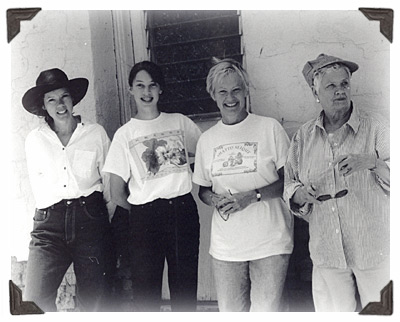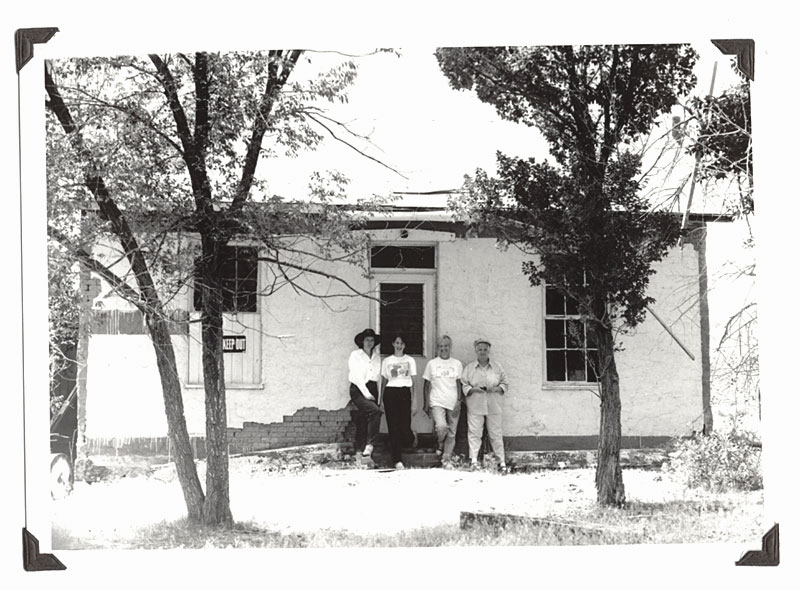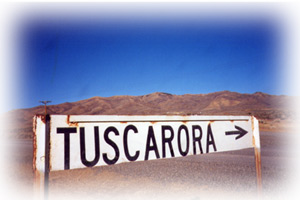

I had some experience in the matter, having lived in two places that had names: the Last Resort and T’wern’t Easy. The summer I was three, my father finished his job as manager of a cattle ranch near Lee, Nevada. At the end of August, we were moving to Colorado, where Dad would run a large sheep outfit. However, my father was obligated to put up the hay before we could leave. We had to vacate the ranch house, so our family camped in a meadow for July and August and called it the Last Resort.
Over the years, I have heard fond stories of the Last Resort. Not afraid of having to “make do,” my parents pitched a roomy canvas tent and built a makeshift outdoor kitchen. During a visit, my grandpa Joe framed up a two-holed outhouse and covered it with corrugated tin. My mother likes to recall young Bill Kane, the neighbor who rode horseback past camp on his way irrigate his hay meadows. “Every morning without fail,” she laughs, “Bill heaved a big old dirt clod at the roof of the tin privy, just hoping to catch somebody inside.”
The second place with a name happened much later in my life. In 1985, my husband and I and our two children made a major transition from the Mendocino Coast to the small inland town of Ukiah, California. We accepted the offer to rent a house on the outskirts of town from retired acquaintances who were ready to travel full time in their Airstream. I can still see the small wooden sign dangling from their mailbox reading, “T’wern’t Easy.” After a couple of months, we simply referred to the place as “Twernt.”
As I look back on the Last Resort and Twern’t, both were humble excuses for homes and each represented an adventure. When I reflect on our purchase of that acre in Tuscarora, I wonder what the three of us were thinking. It definitely was an adventurous decision, but it gives me pause that the three of us chose a place filled with so much refuse and devastation.
There is a logic, though. My mother was on the move all her married life. Camping by a creek in northeastern Nevada in the early years was nothing. Buying a place that was forlorn and run-down was also something she had done before. Whenever the subject comes up of the many moves in her marriage, she says, “That’s right. As a matter of fact, on our thirty-fourth wedding anniversary, your dad and I were at a golf tournament in Twin Falls. That night the two of us went to dinner and got talking about all the places we’d lived. Right then and there I took a pen from my purse and we listed them on a napkin. After thirty-four years of marriage we had already moved forty-three times.” Always she left places cleaner, nicer, and more orderly; always she made a home.
In 1993, the year escrow closed in Tuscarora, my sister’s personal life was somewhat of a wreck. She never did go home to California that summer. She and my mother hired a carpenter and the three of them tore out some walls and stripped others of layers of wallpaper, newspaper, and cheesecloth, leaving shreds of the Salt Lake Tribune, dated 1886, fluttering in the breeze.
Her husband was first amused, then tolerant, finally furious. She had been wonderfully communicative with Mom and me, voicing doubts about her future, joking that if worse came to worse, she could always move to Tuscarora. Once she returned to the Bay Area, I didn’t hear much from her for a while. Her participation in the Tuscarora project never again reached the exuberance and camaraderie of that first summer.
I have always been attracted to the offbeat, the marginal. Tuscarora has a tradition as an artists’ community, and vestiges remain of its glory days in the 1880’s as a booming silver mining town. However, the dominant impression is of shacks and doublewide trailers, car parts, piles of rusted metal, and shards of broken glass twinkling in the dirt. The eleven fulltime residents are an assemblage of allegiances and resentments. The town has character. No one denies that. I immediately loved everything about it.

All three of us felt a renewed kinship with the high desert landscape: the immense sky, the dry clear air, the delicate light at sunrise and the long purple shadows in the evening; the way you can see a high white arc of truck dust for a good seven miles from the Taylor Canyon turn-off, across the hay meadows, and up the gentle grade that leads to Tuscarora.
During the time we were prospective buyers in Tuscarora, locals called this particular property “The Old Caldwell Place,” referring to Tom Caldwell, who sold the property in 1986 to Horizon Mining Company. Horizon gutted the house in preparation to bulldoze it, used the shop for storage and temporary quarters, and, when they went bankrupt, put it up for auction, which was how we acquired it.
We never learned much about Tom Caldwell. I do know that he and his wife lived on an acre littered with car parts, rusty metal, stacks of tires and corrugated tin, and those ten junked vehicles, hoods up, headlights smashed. After countless trips to the dump situated on old mine tailings above town, we had no sentimental attachment to that name.
We heard that the owner before Caldwell was a Frenchman, Louis “Soliel,” but we had never seen the name in writing. As we watered the struggling lilac on the southeast corner of the adobe house or stared at the front window boarded and covered with a Keep Out sign, my sister and I imagined that Louis Soliel was a small, dapper Frenchman. We could just see him in a clean white shirt buttoned at the collar and suspendered black pants, sitting in the living room in Tuscarora thinking of his village in France--“Probably in Provence,” said my sister. We weren’t sure how he got to Tuscarora, but we enjoyed inventing this figure, a cross between a Provencal villager from Manon of the Spring, and our dearly departed grandfather, a fruit farmer from northern Utah.
We even imagined hosting an annual French picnic in his honor, perhaps on Bastille Day. Sitting in the shade pulling nails from usable boards, my sister and I discussed the meal, the baskets and platters of food on a weathered plank over sawhorses covered with a white cloth gleaming in the July sunlight, yet shaded by the dappled light of our lilac, filled with blossoms and tall as the eaves.
One day that first summer I asked the Tuscarora postmistress, Sharon Rhodes, about “Louis Soliel” and the lineage of the adobe house. Sharon was born and raised in nearby Independence Valley. “I knew the Caldwells,” she said without elaboration. “And the Caldwells bought it from a nice old gent who’d been around the valley forever,” she continued as she sorted the North Fork and Jarbidge mail into large canvas waysacks. “His name was Louie Sal-lat,” which, as she said it, rhymed with “that’s that,” and expunged any grandiose picnic notions.
Later that summer I asked Lee Deffabagh if she remembered Louie Sal-lat. “Sal-lay,” she corrected. “Sure, I do. He was a nice old guy. Nona Trembath called him ‘Louie Slats.’” I had encountered Lee on a walk about 6:30 Sunday morning on the hills east of town. She was collecting rusted tin cans for her found art sculptures. Lee, an abstract expressionist painter with a national reputation in the art world, spends from June 1 to September 1 at her house in Tuscarora. She first came there in 1962 and has a wry view of Tuscarora history. “The concept of ownership was a little different in those days,” she said as she kicked loose a half-buried can. “Nona, who had lived in Tuscarora forever, just divided up lots and sold them as she saw fit.”
The comment reminded me of a conversation with James. our best friend in Tuscarora. I had asked him, “How do you get a plot in the Tuscarora Cemetery?”
“Dig a hole,” he replied.
Not only were my sister and I putting sweat equity into making a place in Tuscarora, but we were also spending more time in Elko than we had in years. Although Elko is our hometown, both of us moved away after high school. An hour’s drive from Tuscarora, Elko has Builder’s Mart, WallMart, the Liquor Barn, Raley’s, three great Basque restaurants, family friends, old friends from our high school days, and our mother’s apartment, where we could get hot showers and sit at her kitchen table making plans for the sometimes overwhelming cleanup and remodeling project we had undertaken.
Sometimes I think we were so intent on thinking of names because we didn’t really know why we bought the place. If we could name it right, then we would know what it was supposed to be. We had lots of reasons why it had been a good idea, a great idea: Helen, our widowed mother, could spend the weekends and summers there; it would be a place for family gatherings; it was reclaiming our Nevada roots; it could be a refuge, a safe house, an artists’ retreat. We would spend more time together. It would be a positive project to work on, talk about during the year, when Mom was in Elko and we were at our respective homes in California.
Now, ten years later, it has evolved into my place, not theirs. My sister wants nothing to do with it. She is way too busy dealing with her own life. She hardly speaks to me, and if I were to tell of her grief and disappointments, she’d never speak to me again. My mother, now eighty-nine, lives a few blocks from me in Ukiah. She misses Elko a lot and likes to hear about my trips to Tuscarora with my husband or with my artist friends. What she doesn’t say is how sad she is that it is no longer a joint venture for the three of us.
Yet I still love remembering the morning, during that intense “What shall we call it?” phase, when my mother, my sister, and I were having breakfast at a Basque café in Elko. In the family tradition of ballpoint pen and paper napkin, we listed name possibilities.
“Helen’s Hunch” was a quick reject, although Helen, our mother, did get the credit for acting quickly when the property came up for auction. A menopausal friend implying that our real estate deal was consummated in a hot flash suggested “Raging Hormones”. A smart aleck acquaintance had suggested “Helen’s Used Cars and Beach Front Property,” alluding to the ten wrecked cars and to our proximity to the Glory Hole, a spectacular body of fresh water that had existed since the 1800’s but was widened and deepened during Horizon’s gold mining operations.
Just as we were having a last cup of coffee, an old friend of mine from high school days came over to greet our table of laughing, animated women. He pulled up a chair and we told him the whole story. He chuckled, shook his head, and said, “I don’t know about a name, but I think you should build a big plywood screen, paint it white, and line up your junked cars, like a 1950’s drive-in movie. You know, with the sign across the bottom, ‘Coming Soon.’”
We finally settled on calling our place the Adobe House, which is how it is listed in the phone book.
However, that cloudless summer morning, driving back to Tuscarora, we laughed until our sides hurt, wondering if my old friend had truly christened our crazy enterprise. The fifty-two miles went quickly as we thought aloud about our hopes, dreams, and schemes embodied in this light-hearted venture, all Coming Soon.

about the poet | complete works | eight poems from Tuscarora | rat's country